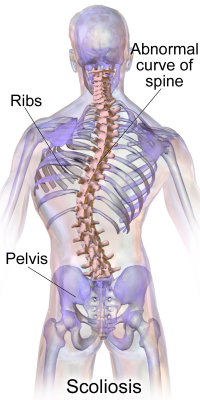Scoliosis
Scoliosis is a condition in which the spine twists and is curved over to one side. Predominantly, this bend happens in either the thoracic or lumbar regions of the spine.

Image: Bruce Blaus Wikipedia
Scoliosis may occasionally be a temporary but often painful problem, caused by such things as an unevenly tilting pelvis, an accident resulting in spinal injury, a prolapsed disc or general mis-use. The condition may also cause sciatica. If such a scoliosis is left unattended, the postural changes may become habitual, leading to long term pain and problems. However, by learning and applying the Alexander Technique, the condition can be managed and a longer-term, more serious outcome can often be avoided.
Congenital Scoliosis
Some people’s spines become distorted during development in the womb, so are they born with congenital scoliosis. Another cause is disorders of the nerves and muscles, such as spinal cord injury and cerebral palsy, which can lead to neuromuscular scoliosis developing. There also seems to be a link with hypermobility syndrome and scoliosis, where a person’s connective tissues are extra flexible and lax. This can make it harder for the spine to be maintained in a lengthened, straighter manner.
Idiopathic Scoliosis
The most common type of scoliosis is when it develops in later childhood during puberty, between the ages of 10 and 18. The spine can deteriorate progressively whilst bones are still growing, and can become severely distorted. The cause for this idiopathic scoliosis is unknown but there may be a genetic component to the condition.
The spinal curvature of scoliosis often causes pain in the back and legs and people can find it difficult to stand up straight. Sometimes the spine tries to compensate for the curvature by creating a second bend in the opposite direction, thus creating a sideways S shape in the spine and torso. In extreme cases, a brace may be worn, or surgery may be required to straighten the spine.
Preventing Deterioration
It is important that juvenile scoliosis is treated early on, to reduce the impact of the condition. Over the years, wear and tear of the joints and intervertebral discs can result in degenerative scoliosis, or adult onset scoliosis. If there has also been overuse and misuse of the body for years, this will exacerbate the condition. Alexander Technique lessons can help people reduce the discomfort and pain that scoliosis can cause and importantly, can help both children and adults to minimise the deterioration of the condition.